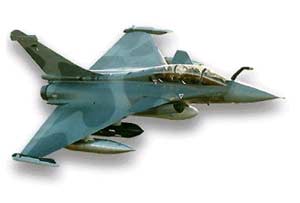Dassault ups the ante with full technology transfer for Rafale
05 Nov 2008
Paris: The French government has cleared full technology transfer for Dassault's Rafale combat jet, one of the six contenders for the Indian Air Force's (IAF) 126 multi-role medium range combat aircraft (MMRCA) tender, which is estimated to be eventually worth atleast $11 billion over its lifetime.
Briefing Indian media representatives at its Champs-Elysées, Paris, headquarters Dassault Aviation's senior vice president for military sales, JPHP Chabriol, said, ''When we talk about technology transfer, we mean full technology transfer and not in bits and pieces.''
 ''The way we work, we first have to obtain clearance of the government before putting in our proposal. If we win the order, we can begin work on transferring technology from day one - unlike our competition,'' he added.
''The way we work, we first have to obtain clearance of the government before putting in our proposal. If we win the order, we can begin work on transferring technology from day one - unlike our competition,'' he added.
Critically for India, the transfer-of-technology (T-o-T) would include that of a state-of-the-art Active Electronically Scanned Array (AESA) radar that would provide Rafale the ability to also function as a close battlefield support airborne warning and control system (AWACS), apart from its designed function as a fighter. The AESA radar T-o-T would also include transfer of software source code, according to Chabriol.
This is a matter of great concern for India, or any country, that seeks T-o-T of sensitive equipment. Lack of access to the source code would not allow a country to re-programme a radar or any sensitive equipment should it so wish.
Defence analysts point out that this could seriously compromise India's national security as the IAF would not be able to re-programme the radar should it wish to at a later stage.
The AESA radar on offer from Dassault is still under development by French aerospace giant Thales and is expected to be integrated with the aircraft by 2012. This is roughly the time the selected aircraft from the MMRCA tender may be expected to enter IAF service.
''We have full faith in the competency of Thales to deliver a top of the line AESA radar,'' Chabriol added.
Two other competing fighters Boeing's F/A-18 Super Hornet and the European conglomerate Eurofighter's Typhoon are also being made available with AESA radars though with the provision that transfer of technology for this equipment would be dependent on the decision of their respective governments.
Earlier statements from manufacturers of AESA radars has been categorical about the fact that transfer of source code is not on the cards. Since source code enables programming of the radar, what this implies is that the IAF would have to specify mission parameters to foreign manufacturers to enable configuration of their radar, seriously compromising security in the process.
''This is not an issue with us. We will not only fully transfer the technology for the AESA radar but also provide the software source code so that that the IAF can programme it in the way it wishes to,'' Chabriol informed journalists.
Apart from the Rafale, the F/A-18 and the Typhoon, other MMRCA contenders are the Lockheed Martin F-16, Saab Gripen and the MiG-35.
The technical bids for the MMRCA tender are currently being evaluated after which all six aircraft will be put through a rigorous testing process at Bangalore, Jaisalmer and Leh.
While Bangalore as as a location is meant to test the ability of these aircraft to operate in the humid conditions of south, Jaisalmer would test their effectiveness in the deserts of Rajasthan while Leh would test their suitability in the Himalayan heights of Ladakh.
The MMRCA tender is meant to replace legacy MiG-21 and other fighters and raise IAF's squadron strength to atleast 39, from the current depleted level of 32.
Chabriol also pointed out that being 100 per cent French also provided Dassault a distinct edge over its competitors on the issue of technology transfer.
''The Gripen is powered by a US engine and has other US components too. Similar is the case with the Eurofighter, which has quite a few American parts. So, they would have to first seek the US government's approval. In the case of the F-18, approval would have to be sought not only of the government but also of parliament (the US Congress).
''This legislative approval is not an issue in our case,'' Chabriol said.













.jpg)






.jpg)









